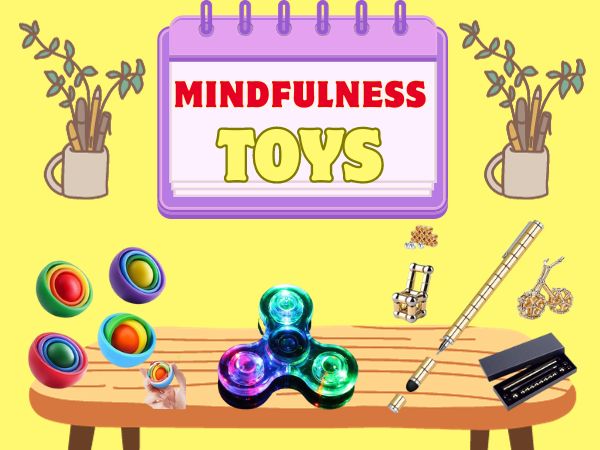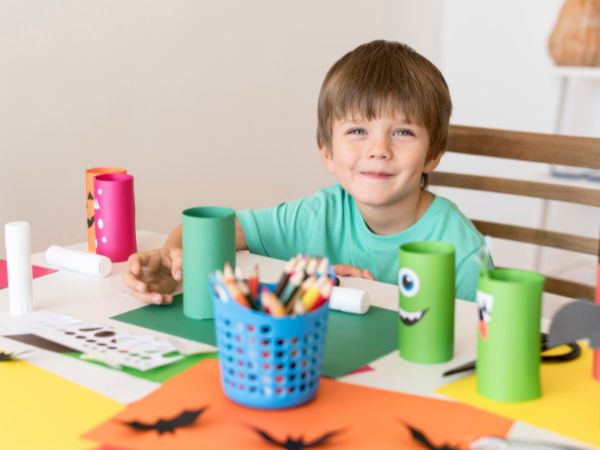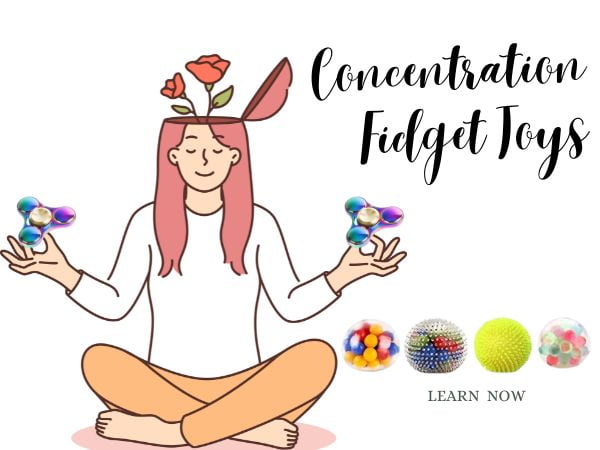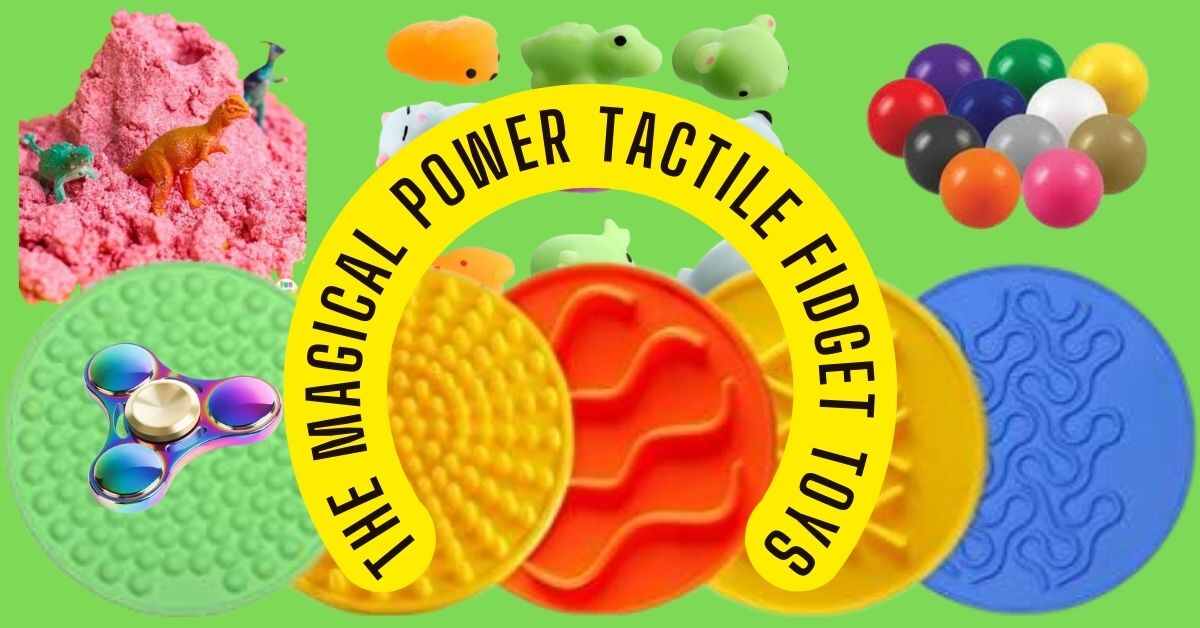1. Introduction
In our modern hustle and bustle of life, where stress has become an unwanted companion, there is no need to panic as handheld fidget toys have quietly emerged as heroes to tackle our challenges. Provide a simple yet powerful tool. This guide provides a highly productive solution through development, science, and a variety of anxiety-relieving gadgets, so stay in this article to get the solution.
Table of Contents
2. The Development of Handheld Fidget Toys
2.1. Historical Roots and Transformations
The story of handheld fidget toys is one of evolution, starting from basic stress balls and transforming into multifaceted gadgets. Understanding their historical roots gives us insight into how these tools have become integral to our stress relief.
2.2. Rise in Popularity of Handheld Fidget Toys: A Cultural Shift
Fidget toys, once niche items, now symbolize a broader societal shift towards mental well-being. This change is fueled by several factors:
- Psychological Recognition: Society’s increasing acknowledgment of mental health has created a demand for accessible stress relief solutions. Handheld fidget toys, once on the sidelines, are now embraced for their stress-reducing benefits.
- Stress in Modern Living: The fast-paced, always-connected nature of contemporary life has escalated stress levels. Fidget toys offer a discreet, portable option for individuals actively seeking ways to find moments of calm amidst the chaos.
- Media and Influencers: Mainstream media and influencers have played a significant role in popularizing fidget toys. Social media showcases people from diverse backgrounds incorporating these devices into daily life, normalizing their use and emphasizing mental health benefits.
- Attitude Shift: Fidgeting is now viewed as a useful strategy for stress reduction and attention, backed by scientific studies. Society recognizes these devices as helpful tools rather than mere distractions.
- Product Diversity: The market’s diverse range of fidget toys, offering various textures, styles, and capabilities, has been crucial. This variety allows individuals to choose toys that suit their preferences and sensory needs, integrating them seamlessly into daily life.
- Integration in Learning Environments: Fidget toys have gained appeal by being incorporated into learning environments. Teachers increasingly permit and promote their use in classrooms, recognizing their positive impact on focus and restlessness.
- Easy Stress Relief: Handheld fidget toys provide a simple and practical way to relieve tension discreetly. Unlike traditional methods that may require specific settings or dedicated time, these toys offer stress relief on the go.
2.3. Key Players in the Fidget Toy Industry
The fidget toy industry, driven by creativity and innovation, has seen significant contributions from key players shaping its landscape. Here’s a glimpse at some influential figures:
- Fidgetly: Pioneered by introducing the Fidget Cube, Fidgetly set a standard for multifunctional fidget gadgets.
- ZURU: A global toy company known for affordable and innovative fidget toys, including spinners and sensory gadgets.
- Tangle Creations: Renowned for the Tangle, an interconnected twisting toy providing a unique sensory experience.
- Tom’s Fidgets: Gained popularity for premium fidget spinners with a focus on high-quality materials and unique designs.
- 3D Fidgets: Specializes in customizable 3D-printed fidget toys, offering a personalized touch.
- Speks: Creates magnetic fidget toys combining the satisfying click of magnets with stress-relieving benefits.
- Fashional: Offers a diverse range of visually appealing fidget toys, emphasizing both functionality and aesthetics.
- Stress Less Company: Dedicated to stress relief, providing a wide selection of fidget toys catering to different sensory needs.
- Möbii: Specializes in mesmerizing Möbii balls, offering a tactile experience for relaxation through touch.
- Sensory Fidgets: Focuses on addressing sensory needs with a range of inclusive and therapeutic fidget toys.
3. Understanding the Science Behind Fidgeting
- Fidgeting, often associated with stress, serves as a natural response to release tension and cope with overwhelming emotions. Handheld fidget toys, designed for this purpose, provide a focused and socially acceptable outlet for nervous energy, offering a tangible way to navigate life’s challenges.
- Physiologically, fidgeting involves small, repetitive movements with various benefits such as increased caloric expenditure, improved blood circulation, boosted metabolism, enhanced focus, stress reduction, and potential neurotransmitter release. While these effects vary among individuals, the use of handheld fidget toys provides a structured way to engage in this behavior.
- Contrary to common belief, fidgeting, particularly with handheld toys, can yield cognitive benefits such as improved concentration, kinesthetic learning connections, stress management, enhanced dopamine release, and personalized focus strategies.
- Recognizing these advantages positions handheld fidget toys as valuable tools for enhancing cognitive performance in educational and work settings.
4. Different Types of Handheld Fidget Toys
Handheld fidget toys come in various shapes and designs, providing a range of sensory experiences for users. Here are some different types of handheld fidget toys:
- Spinner Toys:
- Classic Spinners: These usually have a central bearing with arms that spin around it.
- Tri-Spinners: Spinners with three arms, offering a different balance and spin experience.
- LED Spinners: Equipped with LED lights for visual stimulation.
- Cube Fidgets:
- Fidget Cubes: Small cubes with different features on each face, such as buttons, switches, and rollers.
- Infinity Cubes: Foldable cubes that can be endlessly folded and unfolded.
- Tactile Fidgets:
- Sensory Balls: Squeeze or roll these textured balls for tactile stimulation.
- Tangle Toys: Interconnected curved sections that can be twisted, turned, and shaped in various ways.

- Squeeze Toys:
- Stress Balls: Soft, squeezable balls designed to be squeezed and manipulated to relieve stress.
- Squishies: Soft, slow-rising foam toys that can be squeezed and squished.
- Fidget Pens:
- Click Pens: Pens with clickable buttons for repetitive clicking.
- Spinning Pens: Pens designed for spinning and twirling.
- Pop It Fidgets:
- Pop It Toys: Silicone toys with multiple bubbles that can be popped back and forth.
- Stretchy Fidgets:
- Stretchy Strings: Elastic strings that can be pulled, twisted, and stretched.
- Stretchy Bands: Bands that can be stretched and manipulated with the fingers.
- Bead Fidgets:
- Bead Rollers: Tubes filled with beads that can be rolled between the hands.
- Bead Fidget Bracelets: Wearable fidgets made of stretchy material and beads.
- Scented Fidgets:
- Scented Stress Balls: Stress balls infused with scents for an additional sensory element.
- Aromatherapy Putty: Putty with calming scents for a multisensory experience.

- Gyroscopic Fidgets:
- Gyroscopic Toys: Handheld devices with a spinning gyroscope for a unique fidgeting experience.
- Wrist Spinners: Wearable spinners that attach to the wrist for on-the-go fidgeting.
- 3D Printed Fidgets:
- Custom 3D Printed Fidgets: Personalized fidget toys created through 3D printing technology.
- Magnetic Fidgets:
- Magnetic Rings: Rings with embedded magnets that can be rotated and connected in different ways.
- Magnetic Balls: Small, powerful magnets that can be shaped and molded.

- Grip and Twirl Fidgets:
- Grip Exercisers: Devices designed to strengthen hand muscles by providing resistance.
- Twist and Click Pens: Pens with multiple clickable or twistable features for fidgeting
- Gel-filled Fidgets:
- Liquid Motion Bubbler: Handheld toys filled with colorful liquid that creates a soothing visual effect as it move.
- Pocket-Sized Puzzles:
- Metal Puzzles: Small metal puzzles that can be manipulated to solve.
5. Pros. And Cons. of Handheld Fidget Toys
Here’s a tabular format for the comparative information on different types of handheld fidget toys:
| S.No. | Fidget Toy Type | Pros | Cons |
| 1 | Spinner Toys | – Visually engaging spinning motion. | – Some find the spinning motion distracting. |
| 2 | Cube Fidgets | – Multiple tactile features. | – Not everyone enjoys cube-shaped fidgets. |
| 3 | Tactile Fidgets | – Offers varied tactile experiences. | – May not be as discreet as some other fidgets. |
| 4 | Squeeze Toys | – Effective stress relief. | – May not provide enough sensory engagement. |
| 5 | Fidget Pens | – Combines fidgeting with functionality. | – Limited compared to standalone fidgets. |
| 6 | Pop It Fidgets | – Satisfying popping sensation. | – Popping noise may be disruptive. |
| 7 | Stretchy Fidgets | – Provides stretching and squeezing. | – May lose elasticity over time. |
| 8 | Bead Fidgets | – Combines tactile and visual stimulation. | – May not provide enough sensory input. |
| 9 | Scented Fidgets | – Multisensory with calming scents. | – Scent preferences vary. |
| 10 | Gyroscopic Fidgets | – Unique gyroscopic spinning sensation. | – May be too distracting for some. |
| 11 | 3D Printed Fidgets | – Customizable designs. | – Accessibility may be limited. |
| 12 | Magnetic Fidgets | – Interactive and versatile. | – Small pieces may present a choking risk. |
| 13 | Grip and Twirl Fidgets | – Strengthens hand muscles. | – Not as visually engaging for some users. |
| 14 | Gel-filled Fidgets | – Soothing visual effects. | – Limited interaction compared to others. |
| 15 | Pocket-Sized Puzzles | – Engaging and mentally stimulating. | – might not offer enough sensory information. |
6. Personal Preferences and Customization
1. Material, Texture, and Size Considerations
- Navigate the world of fidget toys based on personal preferences. Consider the material, texture, and size that resonate with you, making the experience uniquely yours.
2. Noise Levels and Social Acceptance
- Consider the noise levels and social acceptance of different fidget toys. It’s not just about choosing one; it’s about selecting one that fits seamlessly into different environments.
3. Age-Appropriate Fidget Toys
- Explore the diverse options of fidget toys suitable for different age groups. It’s not a one-size-fits-all approach; it’s about finding stress relief tailored to specific developmental stages.
4. Aligning Fidget Toys with Therapeutic Goals
- Enhance the therapeutic benefits by aligning your fidget toys with specific stress-relief goals. It’s not just about having a fidget toy; it’s about using one with purpose.

7. The Role of Handheld Fidget Toys in Education
7.1 Incorporating Fidget Toys into Learning Environments
- Handheld fidget toys in education enhance focus, learning outcomes, and cognitive engagement.
- They stimulate neural pathways, cater to diverse learning styles, and reduce stigma.
- Adopting these toys promotes inclusivity, unlocks student potential, and creates a positive learning environment.
7.2 Positive Impact on Focus and Academic Performance
- Research and anecdotes suggest that handheld fidget toys can improve focus, concentration, and academic performance, especially for students with attention difficulties or ADHD.
- These toys provide tactile stimulation, allowing students to maintain attention during tasks.
- They also act as a non-disruptive outlet for excess energy, allowing students to channel their focus into learning.
- Additionally, fidget toys may reduce anxiety levels, contributing to improved cognitive function and concentration.
- For students with ADHD, fidgeting acts as a self-regulation mechanism.
- In inclusive learning environments, these toys cater to diverse sensory preferences, promoting positive educational outcomes.
7.3 Dispelling Myths and Misconceptions
The use of fidget toys in classrooms has become a topic of discussion and, unfortunately, several myths and misconceptions have arisen. Here are some common misunderstandings, along with explanations to dispel these concerns:
- Myth: Fidget toys are distracting and disrupt the learning environment.
- Reality: Fidget toys, when used appropriately, can actually enhance focus and concentration for certain individuals. They provide a non-disruptive outlet for excess energy and can help students maintain attention during tasks.
- Myth: All students will benefit from fidget toys equally.
- Reality: Fidget toys are not one-size-fits-all. Different students have varying needs when it comes to focus and sensory input. While some may benefit greatly from fidget toys, others may find them unnecessary or even distracting. It’s important to assess each student individually.
- Myth: Fidget toys are only for students with attention disorders.
- Reality: Fidget toys can be beneficial for a wide range of students, not just those with attention disorders. Some students simply have a natural need for movement or tactile stimulation to help them concentrate. Fidget toys can be inclusive tools for various learning styles.
- Myth: Fidget toys are a “fad” and have no scientific basis.
- Reality: Research supports the idea that providing sensory outlets, including fidget tools, can help certain individuals improve focus and self-regulation. Occupational therapists often recommend fidget tools as part of sensory strategies.
- Myth: Allowing fidget toys means giving students an excuse to play with toys in class.
- Reality: When implemented properly, fidget toys are not intended for play but for discreet sensory stimulation. Teachers can establish clear guidelines on when and how fidget tools can be used to ensure they serve their intended purpose without causing distraction.
- Myth: Fidget toys are only for younger students.
- Reality: People of all ages, including adults, can benefit from fidget tools. In a classroom setting, students in higher grades may also find them helpful in managing stress or improving concentration during challenging tasks.
- Myth: Fidget toys replace the need for other behavioral interventions or accommodations.
- Reality: Fidget toys are just one tool among many that can be used to support students. They should not be viewed as a sole solution but rather as part of a comprehensive approach to meeting the diverse needs of students in the classroom.

8. Fidget Toys in the Professional Sphere
8.1 Fidget-Friendly Workplaces: Boosting Productivity
- Because they increase productivity, handheld fidget toys like stress balls and squeeze toys are revolutionizing the modern office.
- These tactile instruments improve focus, encourage teamwork, release tension, and spark creativity.
- Implementation techniques include designating specific areas for fidgeting, letting staff members choose the tools they use, and raising knowledge of the advantages of fidgeting.
- All things considered, providing portable fidget toys to workers improves their well-being and increases output.
8.2 Addressing Workplace Stressors
- To lower workplace stress, encouraging healthier work conditions, and developing a healthy work culture, handheld fidget toys are important.
- They create an environment that is more inclusive by providing individualized solutions, encouraging autonomy, dispelling myths, encouraging physical exercise, and preventing stress from getting worse.
8.3 Tips for Integrating Fidget Toys Professionally
To ensure a seamless integration without causing disruption, consider the following practical tips:
- Choose discreet fidget toys: Select small, quiet items to avoid drawing attention.
- Educate colleagues: Share the benefits of fidget toys and promote open communication.
- Use noiseless options: Opt for quiet fidget toys to maintain a peaceful work environment.
- Establish fidget zones: Designate specific areas for fidgeting to avoid disrupting others.
- Encourage breaks: Allow fidget toy use during breaks to manage energy levels effectively.
- Lead by example: If in a leadership role, use fidget toys to set a positive precedent.
- Consider non-visual options: Choose fidget toys that don’t require visual attention to minimize distractions.
- Implement policies: Develop clear guidelines on when and where fidget toys can be used.
- Personal responsibility: Encourage individuals to use fidget toys responsibly to enhance focus.
- Seek feedback: Regularly check in with employees to assess the impact of fidget toys and make adjustments as needed.
9. Handheld Fidget Toys and Mental Health

9.1 Connection to Mental Health Conditions
- Because they help with sensory modulation, attention, stress management, behavior modification, mindfulness, and nonverbal expression, handheld fidget toys are crucial for managing mental health.
- By encouraging focus and concentration, they benefit people with ASD, ADHD, and sensory processing problems.
- By encouraging self-awareness and mindfulness, these toys also help to ground nervous thoughts through repetitive motions, which is very helpful for treating depression and anxiety.
- They should, therefore, be a component of an all-encompassing plan for mental health treatment that also includes medicine and psychotherapy.
9.2 Fidget Toys as Complementary Tools in Therapy
- Therapists utilize fidget toys to help patients who are struggling with mental health issues.
- They establish a welcoming atmosphere, increase involvement and focus, manage emotions, support behavior modification, improve communication, foster mindfulness, and advance self-awareness.
- By giving excess energy a tangible outlet, these toys reduce stress and foster trust between the client and the therapist.
- By seeing how their clients engage with the toys, therapists can pick up important nonverbal clues about their emotional states, stress levels, and areas of concern.
- Therapists can assist clients in managing overwhelming emotions and cultivating mindfulness skills by introducing fidget toys into their treatment sessions.
10. Crafting Your Own Therapeutic Experience: DIY Fidget Toys
10.1 The Therapeutic Value of Creating Your Fidget Toy
- Beyond only the tangible item, making individualized fidget toys has many therapeutic advantages.
- In addition to fostering a sense of accomplishment and reducing stress, it also fosters personalization, mindfulness, sensory engagement, cathartic expression, community, and social connection.
- Additionally, it offers a high degree of customization, giving people the ability to use a tool that is customized to their tastes and sensory requirements.
- Last but not least, creating art can strengthen social ties, lessen feelings of loneliness, and improve mental health in general.
10.2 Simple DIY Projects for All Ages
These projects are not only enjoyable but also help improve focus and concentration. Let’s dive into some easy-to-follow DIY projects suitable for all ages!
- Beaded Fidget Bracelet:
- Materials: Elastic cord, assorted beads.
- Instructions:
- Cut a length of elastic cord that fits your wrist comfortably.
- Thread the beads onto the cord in any pattern you like.
- Tie the ends securely, and your beaded fidget bracelet is ready!
- Tactile Sensory Bottle:
- Materials: Clear plastic bottle, water, glitter, small objects (beads, buttons).
- Instructions:
- Pour halfway into the plastic bottle with water.
- Add glitter and small objects.
- Seal the bottle tightly. Shake it gently to watch the glitter float and soothe your senses.
- Velcro Popsicle Sticks:
- Materials: Popsicle sticks, Velcro dots.
- Instructions:
- Attach Velcro dots to each end of the popsicle sticks.
- Create various shapes or patterns by joining sticks using Velcro dots.
- Change and rearrange the sticks to create endless fidgeting possibilities.
- Fabric Scrap Stress Ball:
- Materials: Balloon, fabric scraps, funnel, flour.
- Instructions:
- Cut fabric scraps into small pieces.
- Stretch the balloon and attach the funnel to the opening.
- Fill the balloon with flour using the funnel, tie a knot, and wrap the fabric scraps around it for a textured stress ball.
- DIY Worry Stones:
- Materials: Smooth stones, acrylic paint, paintbrush.
- Instructions:
- Clean and dry the stones.
- Paint calming designs or patterns on each stone.
- Once the paint is dry, these stones can be used as worry stones for soothing tactile stimulation.
- Sensory Slime:
- Materials: Clear glue, liquid starch, food coloring (optional).
- Instructions:
- Mix equal parts clear glue and liquid starch in a bowl.
- Add food coloring if desired.
- Stir until the slime forms, then knead it with your hands. Enjoy the satisfying sensation of stretching and squeezing the slime.
10.3 Encouraging Creativity in Fidget Toy Design
- Handmade fidget toys provide a special opportunity to practice self-expression and creativity.
- One way to make fidget toys that are distinctive and personalized is to experiment with materials, forms, and textures, rather than sticking to conventional patterns.
- It’s beautiful when you follow your instincts instead of following directions. Because every turn and turn becomes a demonstration of your creativity, this method fosters a sense of ownership and accomplishment.
- Your designs gain character and uniqueness from imperfections like wavy curves or surprising textures.
- Making your own fidget toys is a self-discovery trip as much as an endeavor focused on the final outcome.

11. Common Concerns and Controversies
11.1 Debunking Myths: Fidget Toys as Aids, Not Distractions
- The purpose of fidget toys is highlighted in this article, which dispels myths about them and highlights their benefits for stress management and attention. Myths like the idea that fidget devices cause distractions and disturb surroundings are refuted by it.
- Rather than that, it draws attention to the kinaesthetic learning-based scientific foundation for their efficacy. Benefits from fidget toys include improved cognitive function, stress reduction, and higher concentration.
- The essay promotes a constructive reassessment of fidget toys by highlighting their value as adaptable resources for a range of learning and working methods.
11.2 Addressing Overreliance and Dependence Concerns
- An excessive dependence on fidget toys may result in an increased need for outside stimulation to regulate emotions, which may impede the acquisition of alternative coping strategies.
- Promoting a variety of coping mechanisms, taking societal norms into account, and treating the underlying causes of stress and anxiety are essential.
- Acknowledging these worries is a first step toward an approach to emotional control that is balanced.
12. Frequently Asked Questions (FAQs)
1. Are fidget toys suitable for all age groups?
Absolutely! Fidget toys cater to individuals of all ages, providing stress relief across generations.
2. Can fidget toys replace traditional stress-relief methods?
Fidget toys complement traditional methods, offering an additional layer of stress relief.
3. How do I clean and maintain my fidget toy?
Keep it simple – use mild soap and water for cleaning, ensuring your fidget toy stays hygienic.
4. Are there specific fidget toys for certain conditions?
Yes, certain fidget toys are designed with specific conditions in mind, offering targeted therapeutic benefits.
5. Can fidget toys be used in professional settings without disruption?
Absolutely! Follow our tips for using fidget toys professionally, ensuring a positive work environment.
13. Conclusion: Embracing Calm in the Palm of Your Hand
In addition to serving as stress relievers, and silent companions, handheld fidget toys promote concentration, creativity, and general well-being. These toys, which range from stress balls to homemade crafts, can accompany you on your path to greater mental health.
They promote taking back control and accepting serenity, turning relief into an easy joy. Handheld fidget toys have evolved into effective tools for managing life’s stressors, whether used in the office, classroom, or during therapy sessions.
Take a breath, find your fidget, and let the journey to calmness begin.









